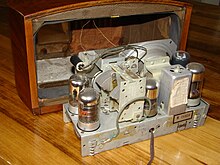The term All American Five (abbreviated AA5) is a colloquial name for mass-produced, superheterodyne radio receivers that used five vacuum tubes in their design. These radio sets were designed to receive amplitude modulation (AM) broadcasts in the medium wave band, and were manufactured in the United States from the mid-1930s until the early 1960s.[1][2] By eliminating a power transformer, cost of the units was kept low; the same principle was later applied to television receivers. Variations in the design for lower cost, shortwave bands, better performance or special power supplies existed, although many sets used an identical set of vacuum tubes.




- ^ "History of the AA5 (All American 5ive) AM tube radio". Wa2ise. Archived from the original on 2017-04-24. Retrieved 2017-01-11.
- ^ Richard McWhorter, The All American Five Radio: Understanding and Restoring Transformerless Radios of the 1940s, 50s, and 60s, Sonoran Publishing, 2003, ISBN 1886606196,, page v.
- ^ Octode converter frank.pocnet.net
